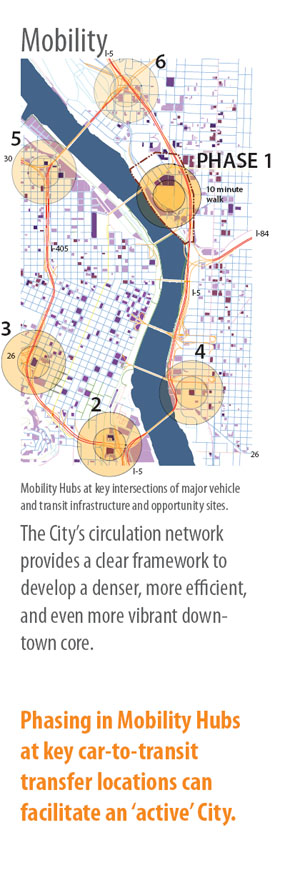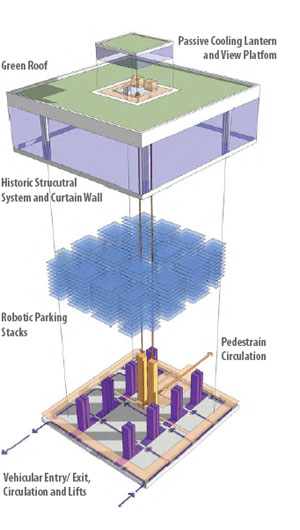The Coolest Park & Ride Ever

As a rule, I try to keep my employer out of HAC, but recent discussions of park & rides combined with a bad case of Portland envy compel me to break that rule presently. For you see, my GGLO colleagues and I just responded to a call for concepts for Memorial Coliseum in Portland’s Rose Quarter. Our concept? Fill it with cars and make a gigantic park & ride out of it. Think I’m kidding? Go ahead, click those links. Here’s what we thunk up:

“We propose to repurpose Memorial Coliseum in a way that will foster Portland’s evolution into a model sustainable city of the future. Our concept begins with the counterintuitive conversion of the Coliseum into a colossal robotic parking garage. And it ends mid-century with the launching of a museum that celebrates the bygone era of the automobile.
“Portland has committed to reducing greenhouse gas emissions by 80 percent by 2050, which will require a two thirds reduction in driving. Over the same time period, the Portland area is projected to grow by 90 percent. Fortuitously, this growth can actually help Portland achieve its GHG goals by increasing density; and the positive impact is maximized if growth is targeted in areas that are already relatively dense, such as downtown Portland. However, under current trends, fitting parking in high-density development places a severe liability on the creation of livable communities. Parking is expensive, consumes vast area, degrades the pedestrian realm, and hamstrings design.
“Our interim solution is to provide parking in peripheral locations, thereby reducing the need for cars to enter the city core, and enabling the core to develop without the impediment of parking. The Rose Quarter is an ideal parking location to serve downtown Portland, as users would have several public transit options to reach their final destinations. We also propose a pedestrian bridge across the river to facilitate walking.
“The Coliseum building is well-suited to hold a modular robotic parking system, and could accommodate roughly 5200 cars. Ideally, it would be one of several such ‘Mobility Centers’ that would ring downtown. Over time, as the city grows and reliance on cars declines, these facilities would be relocated to less urbanized areas.
“Eventually, when parking is no longer needed in the Coliseum, we propose convert it back to a civic use, namely the Car Memorial Museum. The robotic parking apparatus would then be repurposed to store museum specimens (i.e. cars), and to retrieve them on demand for close up display to museum patrons.”

>>>
Anybody still with me? A thought experiment, yes, but not completely disconnected from reality. Because parking is a chicken/egg dilemma: we’d like to be able to design cities for people not cars, but since people are so dependent on cars, we continue to design cities for cars, which keeps people car dependent. Our proposed park & ride “moblity centers” could help break that vicious cycle.
Of course there are any number of reasons why such a model might fail. The biggest challenge would be getting people to use the park & ride given that it would make their trips less convenient. People would need a some kind of incentive to do it, the simplest solution being to make parking much cheaper there than in downtown.
 The concept could also be criticized for the same reason some object to allowing park & rides in Seattle’s station areas—it’s infrastructure that’s supporting car use. On the other hand, it might be praised for many of the same reasons some believe it’s okay to allow park & rides in Seattle’s station areas—because it’s temporary, and has many potential side benefits.
The concept could also be criticized for the same reason some object to allowing park & rides in Seattle’s station areas—it’s infrastructure that’s supporting car use. On the other hand, it might be praised for many of the same reasons some believe it’s okay to allow park & rides in Seattle’s station areas—because it’s temporary, and has many potential side benefits.
But really, the coolest thing about this concept is the final incarnation of Memorial Coliseum as a museum to celebrate the bygone era of the fossil fuels and the automobile:Â the “Car Memorial Museum.” By mid-century, the expectation is that central Portland will have become so dense, pedestrian-friendly, transit-rich, and car-free that the Rose Quarter Mobility Center would no longer be needed, and the Coliseum could be restored to a civic use.
Picture walking up to any one of several observation stations inside the museum, pressing a button to select the specific car from the collection that you would like to check out, and then having the robotic parking mechanism fetch the car and bring it to you, in the same way it once retrieved cars for their returning owners. Methinks we’d have a hit.
>>>
>>>
